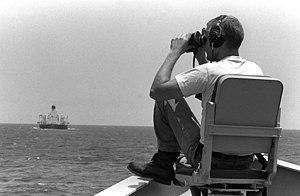This is an old revision of this page, as edited by Kermanshahi (talk | contribs) at 17:29, 8 July 2007. The present address (URL) is a permanent link to this revision, which may differ significantly from the current revision.
Revision as of 17:29, 8 July 2007 by Kermanshahi (talk | contribs)(diff) ← Previous revision | Latest revision (diff) | Newer revision → (diff)| Operation Earnest Will | |||||||
|---|---|---|---|---|---|---|---|
| Part of Iran-Iraq War | |||||||
 Mess Management Specialist 2nd Class Williams Hendrickson scans for mines from the bow of the U.S. Navy guided missile frigate USS Nicholas during an Earnest Will convoy mission. | |||||||
| |||||||
| Belligerents | |||||||
|
|
| ||||||
| Strength | |||||||
|
1 aircraft carrier, 1 amphibious transport dock 4 destroyers 1 guided missile cruiser 3 frigates |
4 frigates 4 Corvettes Several Mine Layers Several Missile Craft | ||||||
Operation Earnest Will (24 July 1987 - 26 September 1988) was the U.S. military protection of Kuwaiti oil tankers from Iraqi and Iranian attacks in 1987 and 1988 during the Tanker War phase of the Iran-Iraq War. It was the largest naval convoy operation since World War II.
The U.S. Navy warships that escorted the tankers were the most visible part of the operation, but U.S. Air Force AWACS radar planes provided surveillance and Army special operations helicopters hunted for possible attackers.
In December 1986, the government of Kuwait asked the Reagan administration to send the U.S. Navy to protect Kuwaiti tankers. U.S. law forbade the use of Navy ships to escort civilian vessels under foreign flag, so the Kuwaiti ships were reregistered under U.S. flag.
Even before Earnest Will formally began, it became clear how dangerous Persian Gulf operations would be. On 17 May, an Iraqi warplane fired two Exocet missiles at the guided missile frigate USS Stark, killing 37 sailors and injuring 21. Iraqi officials said the targeting of the U.S. warship was accidental.
On the very first escort mission, on 24 July 1987, the Kuwaiti oil tanker al-Rekkahre, reflagged as the U.S. tanker Bridgeton, struck an Iranian mine, damaging the ship.
On 15 October, the U.S. tanker Sea Isle City was struck while at anchor by an Iranian Silkworm missile, wounding 18. The U.S. Navy responded by destroying two Iranian oil platforms.
Earnest Will overlapped with Operation Prime Chance, a largely secret effort to stop Iranian forces from attacking Gulf shipping. The most dramatic moment of Prime Chance was likely the September 21, 1987, attack on the Iran Ajr, an Iranian ship converted for use as a minelayer. Using night-vision devices, Army gunship crews watched the Iranian vessel lay several mines, then engaged with miniguns and rockets. A SEAL team landed aboard the vessel and seized it. Several Iranian sailors were rescued from the waters of the Persian Gulf after leaping overboard during the attack. The SEALs scuttled the vessel the following day.
On 14 April 1988, the American frigate Samuel B. Roberts struck an Iranian mine and was badly damaged. Four days later, U.S. forces retaliated with a one-day attack on Iranian warships, armed speedboats, and oil platforms used as naval bases. Dubbed Operation Praying Mantis, it was the biggest engagement of surface warships since World War II. Two Iranian ships were destroyed, and two American pilots died when their helicopter crashed.
On 3 July 1988, USS Vincennes shot down Iran Air Flight 655, an Airbus A300B2, over the Strait of Hormuz. 290 people were killed.
These two side effects of Earnest Will — Praying Mantis and the downing of the airliner — helped convince Iran to agree to a ceasefire on 20 August 1988, ending its eight-year war with Iraq.
On 26 September 1988, USS Vandegrift escorted the last tanker of the operation to Kuwait.
See also
External links
- Operation Earnest Will on GlobalSecurity.org
- Photos of Operation Earnest Will
- Attack Squadron 95
- Photo Gallery of Operation Earnest Will
Further reading
- Peter Huchthausen (2004). America's Splendid Little Wars: A Short History of U.S. Engagements from the Fall of Saigon to Baghdad. New York: Penguin. ISBN 0-14-200465-0.
- Levinson, Jeffrey L. and Randy L. Edwards (1997). Missile Inbound. Annapolis: Naval Institute Press. ISBN 1-55750-517-9. (about the Stark attack)
- Palmer, Michael (2003). On Course to Desert Storm. University Press of the Pacific. ISBN 1-4102-0495-2. (U.S. Navy operations in the Gulf)
- Peniston, Bradley (2006). No Higher Honor: Saving the USS Samuel B. Roberts in the Persian Gulf. Annapolis: Naval Institute Press. ISBN 1-59114-661-5.
{{cite book}}: External link in|title= - Sweetman, Jack (1998). Great American Naval Battles. Annapolis: Naval Institute Press. ISBN 1-55750-794-5. (Account of Operation Praying Mantis)
- Symonds, Craig L. (2005). Decision at Sea: Five Naval Battles that Shaped American History. USA: Oxford University Press. ISBN 0-19-517145-4. (Puts Operation Praying Mantis in broader historical context)
- Wise, Harold Lee (2007). Inside the Danger Zone: The U.S. Military in the Persian Gulf 1987-88. Annapolis: Naval Institute Press. ISBN 1-59114-970-3.
{{cite book}}: External link in|title=
- “Kuwaiti Call for Help Led to U.S. Role in Gulf,” Los Angeles Times, 4 July 1988.
- Naval battles of the Iran-Iraq War
- Naval battles involving the United States
- Military history of the United States 1900-1999
- Operations involving special forces
- History of the United States (1980–1988)
- Military operations involving the United States
- United States-Iranian relations
- Battles involving Iran
- Iran-Iraq War
- Naval battles involving Iran